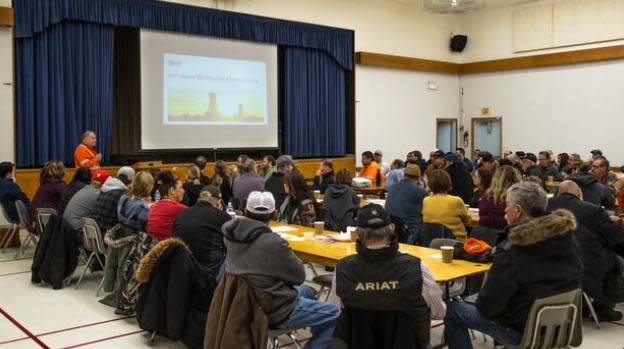Sask. towns, First Nations join forces to maximize benefits, avoid pitfalls of $14B mine project
An unprecedented alliance of more than 50 municipalities and First Nations is taking shape in Saskatchewan.
Its aim? Maximize the benefits, and head off any problems, associated with one of Canada's largest resource projects: BHP's $14-billion Jansen potash mine.
Construction is underway, with more than 2,000 workers on site. Production is expected to begin in 2026, and that could bring thousands of employees, contractors and their families to this rapidly changing region 120 kilometres east of Saskatoon.
The city of Humboldt is expected to nearly double in population to more than 10,000 in the next several years, said city manager Joe Day.
"I think we all realized there's going to be some challenges," Day said. "We can't do this on our own. We need to work together as a group."
In the past, around the world, resource projects have brought economic activity to once-declining regions. But those rapid influxes have often caused a crisis in housing, child care, education, land use and planning and other areas, Day said.
Local government officials would often compete with each other for jobs, contracts and other benefits, he said. The concerns of First Nations were often ignored. And if there was a dispute, no individual community could afford to go up against a multinational resource company's lawyers, accountants and geologists.

BHP officials also said they want to be more responsive to the local community. In the past, they've built housing on site, creating a small city which isn't economically diverse or sustainable. Helping existing communities manage growth is the better approach, they said..
So in east-central Saskatchewan, they're all working to make sure these mistakes don't happen again.
They formed a group called S 4-6. The "S" stands for sylvite, a key component of potash. The communities affected by the Jansen mine are located in both Treaty 4 and Treaty 6 territories, hence S 4-6.
It's a group of more than 50 urban, rural and Indigenous communities near the mine site. Some of these communities had never worked together before.
Day, the S 4-6 vice-president, recently hosted the group at a series of meetings in Humboldt. Day said the Jansen mine was the spark, but this work is long overdue.
"I think everybody's just been overwhelmed at the amount of co-operative spirit and real partnerships that we can envision coming out of this between municipalities, but municipality to First Nation as well. It's really been very satisfying for all of us," Day said.
Brent Sunshine, who works for Fishing Lake First Nation and is S 4-6 president, agreed. He said everyone has agreed to focus on the common ground.
"There's conversations outside of that where it's really about relationship building and different types of governments working together," Sunshine said.

Sunshine and others say the term "reconciliation" can be over-used, but this is its truest form — forging new, meaningful relationships — personal, political and economic.
The S 4-6 partnership is particularly welcome in places such as Leroy, population 510. It's located only minutes from the mine, and big changes are expected.
Mayor Kurt Schreiner said he's confident things will be OK after attending the recent gathering in Humboldt. He said it was incredible to connect with First Nations and other groups.
"I've never seen anything like it before. It was just a feeling; it almost raises the hair, like, under your skin," Schreiner said. "It's just the relationships. It's awesome and I'm excited."
BHP officials say they'll continue to support S 4-6. Karina Gistelinck, the president of BHP's potash operations, said she's worked in places such as Brazil and Australia and has never seen anything like S 4-6.
She said top BHP officials back in Australia are watching closely, and talked about S 4-6 in a recent meeting with global officials. Gistelink said BHP will work with S 4-6 on logistics, support and financing for the region's needs.
"Yes, we will do our part as well," she said.
"So we are looking at incentives for our own workforce to move locally and to facilitate that move locally. We're also looking into our own social investment to actually fund, for instance, child care in the region.… So we're certainly trying to do our part as well in terms of coming to the game with financial aid."
S 4-6 members are getting together again this month. They'll keep working on a plan for their top shared priority: housing. Other priorities include child care, education and labour force development.
They'll figure out a plan, then speak with one voice to BHP and other levels of government.
"I hope we can continue this, and leave a legacy for my kids to be a part of this and work together with everybody else," Schreiner said. "It's good for the area. It's good for everybody, I think."


